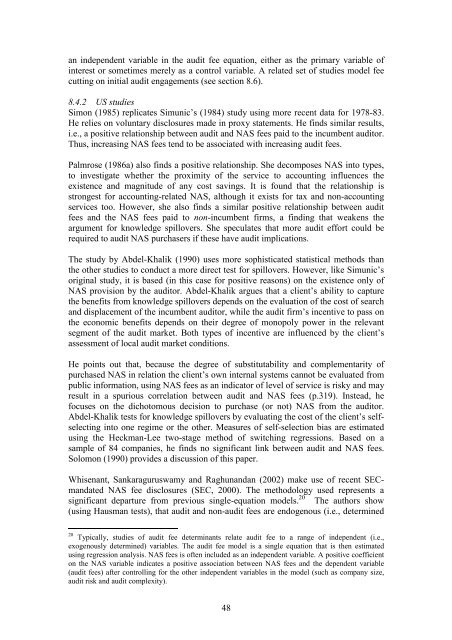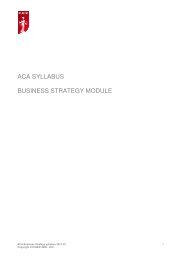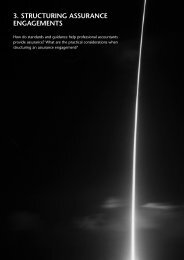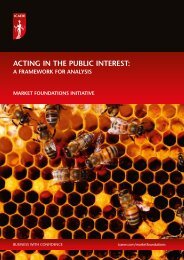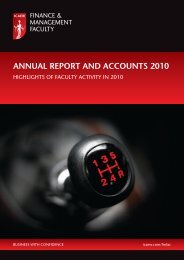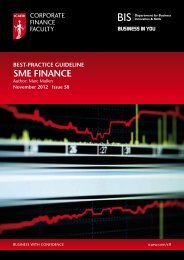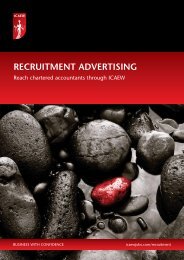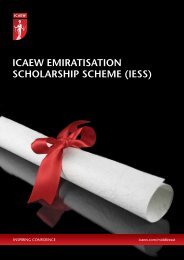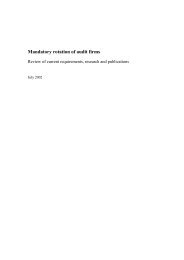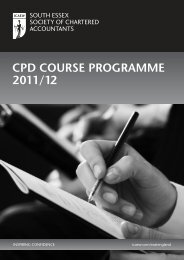Auditor independence and non-audit services - ICAEW
Auditor independence and non-audit services - ICAEW
Auditor independence and non-audit services - ICAEW
You also want an ePaper? Increase the reach of your titles
YUMPU automatically turns print PDFs into web optimized ePapers that Google loves.
an independent variable in the <strong>audit</strong> fee equation, either as the primary variable ofinterest or sometimes merely as a control variable. A related set of studies model feecutting on initial <strong>audit</strong> engagements (see section 8.6).8.4.2 US studiesSimon (1985) replicates Simunic’s (1984) study using more recent data for 1978-83.He relies on voluntary disclosures made in proxy statements. He finds similar results,i.e., a positive relationship between <strong>audit</strong> <strong>and</strong> NAS fees paid to the incumbent <strong>audit</strong>or.Thus, increasing NAS fees tend to be associated with increasing <strong>audit</strong> fees.Palmrose (1986a) also finds a positive relationship. She decomposes NAS into types,to investigate whether the proximity of the service to accounting influences theexistence <strong>and</strong> magnitude of any cost savings. It is found that the relationship isstrongest for accounting-related NAS, although it exists for tax <strong>and</strong> <strong>non</strong>-accounting<strong>services</strong> too. However, she also finds a similar positive relationship between <strong>audit</strong>fees <strong>and</strong> the NAS fees paid to <strong>non</strong>-incumbent firms, a finding that weakens theargument for knowledge spillovers. She speculates that more <strong>audit</strong> effort could berequired to <strong>audit</strong> NAS purchasers if these have <strong>audit</strong> implications.The study by Abdel-Khalik (1990) uses more sophisticated statistical methods thanthe other studies to conduct a more direct test for spillovers. However, like Simunic’soriginal study, it is based (in this case for positive reasons) on the existence only ofNAS provision by the <strong>audit</strong>or. Abdel-Khalik argues that a client’s ability to capturethe benefits from knowledge spillovers depends on the evaluation of the cost of search<strong>and</strong> displacement of the incumbent <strong>audit</strong>or, while the <strong>audit</strong> firm’s incentive to pass onthe economic benefits depends on their degree of monopoly power in the relevantsegment of the <strong>audit</strong> market. Both types of incentive are influenced by the client’sassessment of local <strong>audit</strong> market conditions.He points out that, because the degree of substitutability <strong>and</strong> complementarity ofpurchased NAS in relation the client’s own internal systems cannot be evaluated frompublic information, using NAS fees as an indicator of level of service is risky <strong>and</strong> mayresult in a spurious correlation between <strong>audit</strong> <strong>and</strong> NAS fees (p.319). Instead, hefocuses on the dichotomous decision to purchase (or not) NAS from the <strong>audit</strong>or.Abdel-Khalik tests for knowledge spillovers by evaluating the cost of the client’s selfselectinginto one regime or the other. Measures of self-selection bias are estimatedusing the Heckman-Lee two-stage method of switching regressions. Based on asample of 84 companies, he finds no significant link between <strong>audit</strong> <strong>and</strong> NAS fees.Solomon (1990) provides a discussion of this paper.Whisenant, Sankaraguruswamy <strong>and</strong> Raghun<strong>and</strong>an (2002) make use of recent SECm<strong>and</strong>atedNAS fee disclosures (SEC, 2000). The methodology used represents asignificant departure from previous single-equation models. 20 The authors show(using Hausman tests), that <strong>audit</strong> <strong>and</strong> <strong>non</strong>-<strong>audit</strong> fees are endogenous (i.e., determined20 Typically, studies of <strong>audit</strong> fee determinants relate <strong>audit</strong> fee to a range of independent (i.e.,exogenously determined) variables. The <strong>audit</strong> fee model is a single equation that is then estimatedusing regression analysis. NAS fees is often included as an independent variable. A positive coefficienton the NAS variable indicates a positive association between NAS fees <strong>and</strong> the dependent variable(<strong>audit</strong> fees) after controlling for the other independent variables in the model (such as company size,<strong>audit</strong> risk <strong>and</strong> <strong>audit</strong> complexity).48


